Residential EV Chargers
Commercial EV Chargers
DC Chargers
At Ocular Charging, we believe that DC charging is the cornerstone of the future of electric vehicle (EV) infrastructure in Australia and New Zealand. Beyond simply selling chargers, our goal is to make the switch to EVs as easy as possible and get you back on the road. With the widest selection of dependable, adjustable, and modular charging stations in Australia and New Zealand, we’re ready to grow with your evolving charging needs.
Ocular Charging offers an extensive range of DC fast chargers, spanning from 30kW to an ultrafast 420kW. Whether you are investing in fleet electrification of light or heavy vehicles or public charging, we have a DC solution that is appropriate for any application. You can be sure that you are always covered as our chargers pair with any EV available on the market.
OCCP Compatibility
Certified OCPP-based charger management solutions are compatible with every one of our DC chargers. This makes it possible to handle chargers and end-user payments in detail. You may increase your revenue and give users the most easy tap-and-go payment option by adding a Nyax credit card module for public billing.
Agnostic Load Control
Agnostic load control is also made possible by OCPP compatibility, allowing you to securely regulate every charger on your network. From the beginning, our range is intended to be expendable. Together AC and DC chargers can be connected to sophisticated, dynamic load control technologies created in partnership with CSIRO. This setup can easily accommodate the installation of more chargers as you proceed on your electrification journey.
Industry-Leading CCS2 Cables
Industry-leading Phoenix Contact CCS2 cables, with adjustable cable lengths, are standard on all models. Two cars can be charged simultaneously on all dual-port versions, sharing the charger’s total power and making the most use of your infrastructure.
The Ocular Titan series provides the finest values in DC charging available on the market, combining amazing speed with a small and lightweight design. There are two configurations of the Titan: a 60kW version with two charging connections and a 30kW version with just one port. Its wall – or pedestal mounting options make it a dependable, reasonably priced, and simple-to-install solution for public and commercial charging applications.
The Atlas series improves flexibility and speed of charging. To improve the user experience, it comes with an integrated cable management system and is available in sizes ranging from 60kW to 180kW. For individuals who require a more versatile and high-capacity charging option, this series is ideal.
Ocular Atlas Ultra-Fast Series
The Ocular Atlas Ultrafast series comes in combinations ranging from 240kW to 420kW for the maximum capacity. This approach promises to quickly restore fleet cars or users’ access to the road. It has a strong cable management system in the swing-arm form that makes charging quick and simple.
System serviceability is essential to Ocular Charging’s design philosophy. Our goal is to offer long-lasting, suitable infrastructure. Every one of our chargers is constructed from modular components, which include sturdy DC modules made to endure the harsh Australian and New Zealand climates. Maintenance is made easier by service engineers’ easy access to all interior components. Additionally, we locally keep all spare components in stock to maximise the uptime of your infrastructure.
With a robust local support staff at Ocular Charging, you can count on dependable help when you need it. You can be sure that your infrastructure for charging will always be operational and effective.
We offer a charger for every need. Get in touch with us or any of our dependable resellers, and allow us to assist you with your electrification journey. Please visit us at https://ocularcharging.com.au/ for further details. We look forward to seeing you on the road soon!
Have any further questions please contact us:
1300 912 650
With EV sales in Australia rapidly growing you will want to know how much it will cost before you choose to make the switch to electric.
We get down to the real numbers to find out just how much it costs to charge an electric vehicle. It is important to remember, the battery size and charging rate of all models of electric cars is different therefore will vary in charging time and energy consumed. Prices will also vary as energy rates change – just like petrol from a service station.
The Cost of charging an electric car is found by multiplying the size of the battery by the applicable electricity rate (e.g. 60kWh x 0.45 per kWh = $27).
Calculations are based on average usable battery capacity of 65kWh.

For level 2 charging stations, the average charging costs are
*average usage rates of flagship market from five leading electricity retailers as of October 2022
| State | Average Electricity rates | Average Full battery Cost | Average Cost per 100km |
| VIC | 21.12c/kWh | $13.73 | $3.80 |
| QLD | 25.45c/kWh | $16.54 | $4.58 |
| NSW | 28.54c/kWh | $18.55 | $5.14 |
| SA | 36.13c/kWh | $23.48 | $6.50 |
With petrol pricing spiking the average national price of petrol sitting at $1.71 per litre. Using 11L/100km, petrol will cost $18.81 per 100km, at least 3x the price of EV charging.
Rapid fast chargers use DC power to charge your car battery quicker, this increase in speed also increases price.
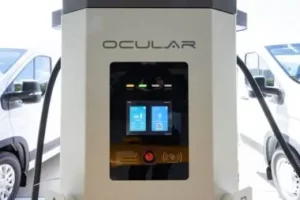
DC Rapid Chargers allow for an extremely fast charge rate, with their power capacities ranging from 40 kW all the way up to 350kW. A full charge can hence take between 10 minutes to 1 hour to complete. Charging at a DC station can cost you between 40 to 60 cents per kWh.
| Electricity Cost | Average Full Battery Costs | Average Cost / 100 km | Average Cost / km |
| 40 cents / kWh | $26 | $7.20 | $0.072 |
| 60 cents / kWh | $39 | $10.80 | $0.108 |
According to Transport for NSW, EVs are significantly cheaper to run in terms of fuel and maintenance. Overall, for the everyday driving needs of the average Australian Home EV charging should be sufficient and the most economical method for charging your electric car.
In 2022 the NSW government, partnered with the Electric Vehicle council, introduced an Electric Vehicle charging grant to invest $20 million in EV chargers for tourist destinations across regional NSW. The grant can be applied to businesses installing chargers from the approved list of AC EV chargers and EV charger software, including Ocular IQ Commercial and IQ Dual Port Tower. These grant approved chargers available through our distribution partner, EVSE. The first round ends November but multiple funding rounds will be available until 2024.
According to NSW Gov:
The grants will fund the following for up to 4 EV chargers per site:
To be eligible, you must be:
Prepare for application and check your eligibility here. If your business meets the criteria, you will be able for apply for the EV chargers grant here. Ensure you choose the charger best suited to your site and budget and it is best to speak to a licensed electrician prior to application to understand the specific installation requirements and costs for the site, charger installations vary depending on the layout. However, 75% of the installation costs is covered by the grant.
For businesses installing less than three co-funded chargers or a destination with less than 100 parking spaces, a software subscription is not required but still available for those who want to apply. More than 3 chargers or 100 parking space must purchase the 2-year software subscription.
The NSW government will notify successful applicants within 6 weeks of the application, if unsuccessful, reapplication is accepted in the next round of grants. Chargers are required to be installed within 4 months of the successful application. Payment will be made once the chargers have been successfully installed to the site within the given time frame.
Australia is starting to catch up to electric vehicle adoptions seen in other areas like Europe so investing now will future proof your business for the transition to electric. Investing in electric vehicle charging will allow your business to attract people to your location looking for a charging spot from online charging location maps. As the AC chargers do not charge as fast as DC, visitors will be at your location longer meaning more potential for greater revenue for any business. The NSW grant includes a range of software including our favourite, Exploren, which allows you to generate another source of revenue through a billing service. You can easily set the charging costs and billing is automated, meaning greater profit and less work!
Contact us or our partner EVSE to install Ocular Chargers for your business.
With electric cars gaining popularity, more people are starting to realise the benefits of a DC Fast Charging Station. Fast charging is critical infrastructure in Australia, especially for long-distance travel and the future of EV adoption. But this is a new technology and with it comes many questions. What is DC charging? Which charger should I choose? Are chargers worth it? How much electricity do I need to charge? In this guide, I will address all your questions and help you decide if DC charging is for you.
The term ‘fast charging’ is heard a lot when talking about electric vehicles but what exactly is DC Fast Charging? The simple idea of DC charging is to directly charge the battery with the type of power required. The battery of an electric vehicle needs DC (direct current) power but the electrical grid provides AC (alternating current) power.
DC charging stations will convert the energy within the charging station from AC to DC before being plugged into the car. This skips the process of converting power after it enters the car and makes charging your electrical vehicle much faster and more efficient.
If you are looking for a residential charger, a DC charger is unnecessary and unrealistic. DC chargers are suitable for high turnover areas where fast charging is essential such as along major highways, petrol stations and commercial fleet car parks. The main benefit is faster EV charging in 1-2 hours (on average for electric cars), rather than 6-9 hours of charge time for an AC charger. This type of charging is perfect for commercial businesses where the duration of stay is usually under an hour, such as the local grocery store, fast-food restaurant, or service stations. DC charging is also common in commercial fleets where vehicles are constantly on the move, especially trucks and vans.
The output of our DC chargers ranges from 30kW to 150kW. The higher the number, the more energy the charging station will use and therefore how much faster it will charge a vehicle. Although it charges faster, the charger also uses more energy therefore your site must be assessed to understand the energy limitations. All models of our DC charging range have dual charging capabilities, with the 120kW model charger having the most versatility of 2x DC, AC and e-bike simultaneous charging. The ideal charger will be dependent on the site and how the charger will be used. If you want to find out the best DC charging station for your site, it is best to speak to our team.
To support the fast-charging capabilities of a fast charger, a significant level of electricity is needed. Each DC charger requires different levels of energy input. For the 60kW model, 100 amps per phase. The 120kW requires 230 amps per phase and the 150kW requires 250 amps per phase. These input levels are based on each DC charger, therefore the more chargers on the network, the more energy is needed. It is essential to speak to a qualified electrician to ensure your site can handle the energy input levels for the DC charger.
If you are looking to invest in EV charging now to prepare for the future, a DC charger is a great option. As the market for EVs continues to expand, DC chargers will only grow in demand and are a great way to promote your business’ sustainability goals. Oculars’ diverse range of EV chargers makes it easy for you to invest in infrastructure for the future. Consider where you will be charging, how often and the size of the vehicles. Our expert EV team will guide any installer on a DC charging project.
Australia is far behind in the world of electric vehicles, less than 4% of all new vehicle sales are electric. Although this number is increasing, it has become apparent Australia does not have the appropriate infrastructure to support this change. The high demand for EVs and government subsidies for purchase are driving the need for quality DC public charging facilities.
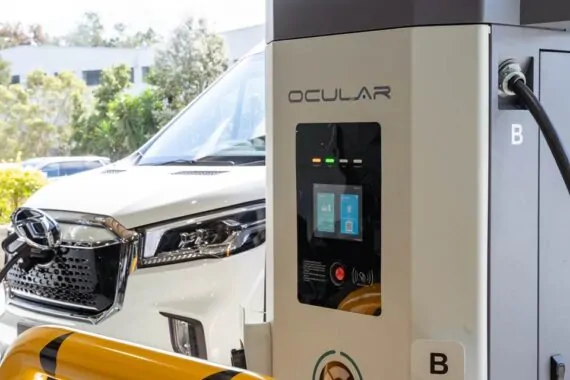
DC Chargers generally provide electric vehicles with full charge in less than an hour, depending on the power of the charger it could be as little as 15 minutes. Therefore they are installed in high-turnover areas and along major highways. The implementation of DC charging stations is incredibly important for the mainstream adoption of electric vehicles in Australia. The number one factor discouraging the purchase of an electric vehicle in Australia is accessibility to charging infrastructure and range anxiety. Range anxiety – the fear of driving an EV and running out of power – is a major issue internationally for EV drivers but, due to there being vast distances between major cities, it is even more prominent in Australia.
For electric vehicles to become the standard, as the local and federal governments are encouraging, the public needs to have confidence in their electric vehicle to arrive at their destination. The installation of quality public charging infrastructure across major roads, especially in regional Australia, will decrease range anxiety and encourage the purchase of an EV. DC charging stations are especially important due to the low charge time allowing for high turnover in public areas.
As the ownership of electric vehicles continues to become more affordable, the demand for public infrastructure will continue to increase. Recent headlines of over an hour queue to use a DC charger emphasise how unprepared Australia is for the inevitable electrification of cars for the general public. While many metropolitan areas are seeing the installation of AC and DC charging stations, the regional areas are lacking quality infrastructure. This affects the willingness of locals of regional areas to purchase an EV and more so, visitors to the area who do not have access to a home charging station.
Ocular’s mission is to solve the need for a simple yet reliable solution to power Australia’s sustainable future. Our expanding offering of DC charging stations ranging from 60kW to 150kW ensures an appropriate solution for all businesses looking to support Australia’s sustainable future.
At Ocular Charging, we’re committed to providing fast, reliable, and high-quality EV charging solutions to our partners.
We’re excited to announce that we recently collaborated with The National Roads and Motorists’ Association (the NRMA) to upgrade and extend the EV-charging infrastructure at The International Convention Centre Sydney (ICC Sydney) in preparation for Fully Charged Live.
Once the NRMA finalized the request, we immediately commenced the project and accomplished it within just a week, providing two types of Ocular hardware: Ocular IQ Dual Tower and Ocular IQ Commercial Single Port charging hardware (7 kW) that were installed by our partner – EVSE Australia. This advanced technology allowed for the simultaneous charging of up to 25 EVs, offering convenience and accessibility for attendees throughout the event.
In addition, we took care of branding and wrapping the chargers to align with the NRMA’s specifications, resulting in a seamless integration of our charging hardware with the Convention Centre and Fully Charged Show’s modern look and feel.
Last but not least, we are pleased to announce that the NRMA decided to allow public usage of the EV chargers free of charge. This is a significant step towards encouraging sustainable transportation and reducing our collective carbon footprint. We thank the NRMA for this initiative and look forward to seeing more organizations follow suit.
At Ocular Charging, we’re proud to partner with the NRMA and other organizations to provide top-notch EV charging solutions. We believe that sustainable transportation is the way of the future and are dedicated to making it more accessible for everyone.
If you’re interested in learning more about our Ocular IQ Dual Tower and Ocular IQ Commercial Single Port charging solutions, please contact our team at :

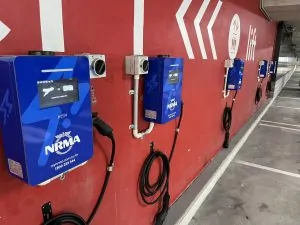
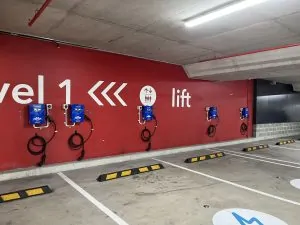
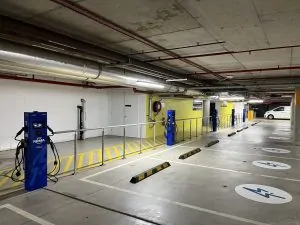
The National Construction Code (NCC) has introduced new requirements for EV charging infrastructure in carparks associated with certain building classes.
As per the latest NCC update, parking lots in Class 2, 3, 4, 6, 7b, 8 or 9 buildings are required to have electrical distribution boards (DB – EV) specifically dedicated for EV charging. These new DB-EV need to be installed on every floor of the parking lot and labelled to indicate that they are dedicated for EV charging equipment.
Electrical distribution boards devoted to EV charging in parking lots for Class 2 buildings are required by the NCC to have the ability for every circuit to accommodate an EV charger that can provide a minimum of 12kWh every day from 11:00pm to 7:00am.
There are stricter criteria for Class 3 buildings. Every circuit on the electrical distribution boards needs to be able to accommodate an EV charger that can provide a minimum 48kWh everyday between 11:00pm and 7:00am. This is due to the fact that EV charging demand is frequently higher in Class 3 buildings – that is, hotels and motels – than in other building classes.
Electrical distribution boards for Class 5 to 9 buildings must be able to handle an EV charger that can provide a minimum of 12 kWh per circuit, every day, from 9:00am to 5:00pm. This is due to the fact that during the day, there is typically a greater demand for EV charging at these buildings, which contain offices and retail spaces.
The DB-EVs must also be sized to support the future installation of a 7 kW (32A) Type 2 EV charger in:
It’s important to remember that stand-alone Class 7a buildings – which are defined as parking lots for public use, like commercial parking lots – are exempt from the rule.
The NCC further stipulates that electrical distribution boards intended for EV charging have to be equipped with a load management system that can schedule and regulate EV charging in response to the overall demand of the building. They must also have room for separate sub-circuit electrical metering so that the electricity used by EV charging devices can be tracked.
The overall goal of the NCC’s requirement modifications is to promote the installation of EV charging infrastructure in parking lots connected to buildings where people live permanently or frequently visit. Through ensuring that buildings have the infrastructure needed to charge EVs, the NCC seeks to encourage the use of EVs and advance environmentally friendly modes of mobility.
Since each Australian state and territory has its own adoption procedure, the NCC 2022 has been adopted in different ways. By mid-2023, it is anticipated that every state and territory will have ratified the NCC 2022. It’s crucial to keep in mind that certain jurisdictions may adopt the code with slight modifications or delayed start date. To find out the precise adoption date and any local modifications, get in touch with the appropriate authorities in your jurisdiction.
Examples of each class of building:
| Class of building | Type of building |
| 1 | Houses; standalone single dwellings of a domestic or residential nature |
| 2 | Apartment buildings; multi-unit residential buildings where people live above and below each other. May also be single storey attached dwellings with a common space below. |
| 3 | Residential buildings other than class 1 or class 2 buildings. Common place of long term or transient living for a number of unrelated people. E.g, boarding house, dormitory accommodation, etc. |
| 4 – part of a building | Sole dwelling or residence within a building of a non-residential nature. E.g, caretaker’s residence in a storage facility |
| 5 | Office buildings used for commercial or professional purposes |
| 6 | Place for the sale of retail goods or the supply or services direct to the public. Typically shops, restaurants and cafes. |
| 7 | Storage-type buildings. |
| 8 | Building in which a process is carried out for trade, sale or gain. I.e, factory |
| 9 | Buildings of public nature. I.e, hospitals, schools, aged care, etc. |
| 10 | Non-habitable buildings. I.e, sheds, carports, etc. |
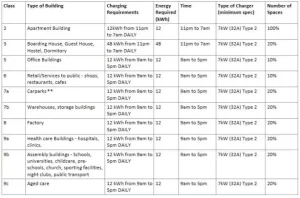
See below for a summarised table on the different class of buildings:
** DB-EV required on each storey of the carpark
Want to learn more? Contact us: